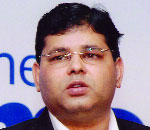 |
Rajnish
R
(Head, digital marketing revenue and strategic business Windows
Live & MSN India)
User-generated content (UGC) is already attracting advertising.
In Windows Live Spaces, for example, we run banner advertising
for people. There are various blogs in which search keywords
are deployed and people are making
|
money out of those search keywords.
Typically, if I have written about my travel experience to Hawaii,
then somebody who�s selling a tour package in Hawaii will actually
be saying, �Please serve my keyword wherever there is UGC which
matches with the word Hawaii�.
Search advertising in UGC will be huge and close to 40 per cent
of the world�s search queries will come out of UGC.
Go to any famous blog. Most of them have search keywords deployed
and there is a lot of advertising on these blogs. Look at MakeMyTrip,
eBay and naukri - they are all advertising on blogging sites.
Right now close to about $3 million in India is going into UGC.
The maths is very simple. The share of page views UGC will have
of the total page views in the market is the share of revenue
it will have. If there are more pageviews on UGC there will
be more ads served on UGC. In the online world, the share of
pageviews is like the Holy Grail. If you don�t have page views
then you cannot monetise. |
| |
|
 |
Manish
Agarwal
(Vice president, marketing, Rediff.com)
Online advertising is moving towards �contextual advertising�
as manifested in growth of P4C (pay for click) platforms
enabled by content and context sensing by service providers
like rediff.com. UGC does not change the principles of online
advertising. It only leverages on
|
collective creativity and wisdom of the crowd. It enriches user
experience as the content is by real people, for real people
and in real time. Brands will need to pay critical attention
to ad copy while designing online ads and incorporate words
which match the most frequently used �phrases� and �tags� used
to describe a particular category in user generated postings.
UGC also opens up blogs and message boards as an alternative
channel to reach out to a highly opinionated, yet very influential
group of users and customise their proposition to these guys.
This set of audience will spread the word in their posts and
influence groups provided, that the brand has made a very unique
and fresh offering to them. |
| |
|
 |
Faisal
Farooqui
(CEO, Mouthshut.com)
The concept of UGC is not new to India. Mouthshut for example,
has been doing it for six and a half years. It is only now
that we have come up with the name UGC. For an advertiser
this may not seem like a separate segment on the internet,
but�from a publisher�s perspective it
|
was
always a separate segment on the internet.
I think advertisers will be excited. Our experience working
with advertisers on Mouthshut has shown that people on UGC are
more focused as opposed to an audience that is visiting a portal
to chat or for�emailing or to read the news.
In UGC there is a central focus. On Mouthshut we are building
a community which wants to talk about products and services.
On a social network, the chances are that you want to find out
people. If the audience is reading a review about cellphones,
the chances are that the advertiser will get a focused audience
for�his cellphone advertisement than in say, Rediff, where he
goes to check his e mail.
The concept will definitely grow because ultimately people like
to read about peer contribution rather than what an expert reviewer
thinks about a product. Tata Sky, ICICI and Citibank have advertised
on Mouthshut. There are some instances where users s have started
making money with search keywords etc. but that number is not
very large in India right now.
|
| |
|
 |
Naveen
Athresh
(Project Manager, Aapkavideo.com)
UGC can cover myriad aspects. Consider the advancements in
web�2.0 with concepts such as blogging.�Then we have user
experience coming into media websites with concepts such as
citizen journalism with people posting videos of their experiences
to share with others.
|
Youtube�s acquisition by Google for $1.65 billion made all the
headlines because here was a company that really did nothing
more than just post user generated videos and yet�was raking
up a lot of interest with millions of subscribers and�hits alike.
Suddenly everyone�� consumers and advertisers - was interested.
We, at aapkavideo, have always believed that convergence in
media is touted as being the next big thing that will happen
in Web 2.0 parlance. This convergence is a�paradigm shift in
the way people communicate as it essentially plays into the
hands of the advertisers. As this concept gains traction, this
change will be visible�in the way people communicate and the
way they share experiences - user experiences � regular text
blogging or video blogging or a combination of both.
Who knows, the next time an individual purchases a product/service,
you could have the individual posting the feedback on what the
pros and cons of that particular product are. What does this
mean to the company selling that product/service?
In the broad sense, it will be increasingly careful about the
quality of the product and the��after sales� service since the
entire scene has shifted dramatically and transparency has been
brought in.
Advertising and marketing believe in user involvement to seek
user attention and what better way to do it than to have�this
involvement and an instant feedback mechanism? |
| |
|
Reported
by Chumki Sen
|

